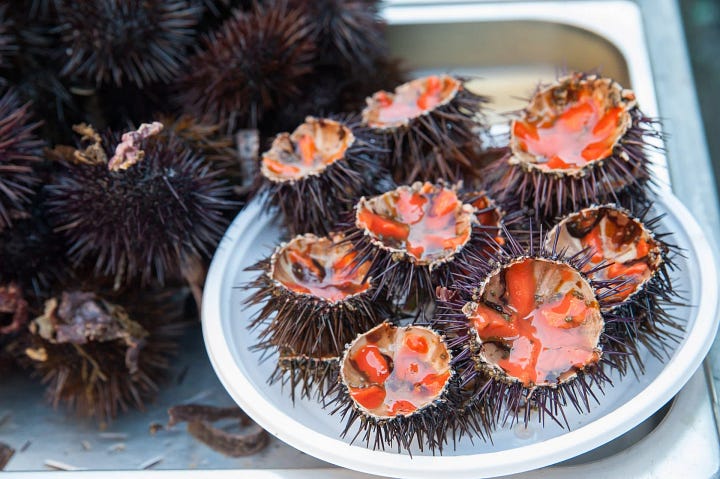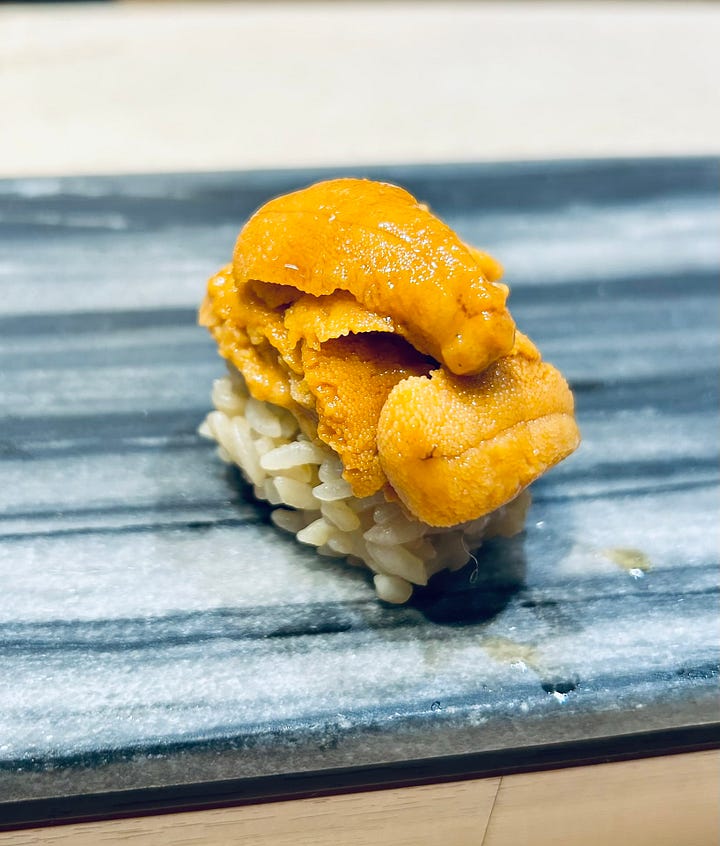This post is for my paying subscribers. It includes a step-by-step recipe and a downloadable PDF.
A World Without Crudo
When I was a child, nobody ate raw fish in Italy.
I'm talking about the 1980s, and I used to spend a couple of months every year in Sicily, surrounded by fish and in a family involved in tuna fishing. I never saw anyone eat crudo, or tartare, and certainly not sushi.
Puglia’s Quiet Revolution
Before continuing this conversation, I feel the need to mention one exception: the region of Puglia. My family has no connection to the beautiful heel of the boot, but I do remember a close friend of my parents from there who used to eat everything raw — to the horror of my mother. I'm told that the tradition of eating raw seafood in Puglia is very old, especially among fishermen, but that it experienced a boom in the 1970s and ’80s. Among the seafood consumed raw and “just fished,” you’ll find octopus, oysters, sardines, anchovies, and — most shockingly — mussels.
Mussels are often called spazzini del mare (“garbage collectors of the sea”). They feed by filtering large amounts of seawater to extract microscopic organisms, plankton, organic particles, and sediments. In doing so, they actually help clean the water and contribute to the health and balance of marine ecosystems. But because they filter everything, mussels can also accumulate harmful and toxic substances, making them quite dangerous to consume raw. They can carry bacteria, viruses, toxins, and possibly heavy metals and chemicals if their habitat is polluted.
Commercially farmed mussels are generally considered safer, as they’re harvested in clean, monitored waters, properly chilled and stored, and sometimes even flash-frozen to kill parasites. Similar conversations could be had about oysters — and I’m no expert on the matter — but those are generally considered safer.
The point I'm making here is that people from Puglia never cared much about these risks. They especially value eating raw seafood directly at the harbor, when the catch is fresh off the boat. I even read somewhere that they might have a stronger microbiota from lifelong exposure… but I digress.
Sea Urchins and Sunlight
In Sicily, we have always eaten raw sea urchin (is there any other way?). One of my fondest childhood memories is going to catch sea urchins with my uncle. We would go snorkeling in waters no deeper than 4–5 meters, near the town of San Vito Lo Capo in Sicily. I remember the rocky sea bottom being completely covered in sea urchins.
My uncle used to tell me — and this was common belief back then — that you could only eat the female sea urchins (because you’d be eating their eggs), and that you could tell them apart from the males by their color. To me, they all looked black, but when the sunlight hit them at the right angle, you could see different shades of dark red, and sometimes even blue. We would collect about a hundred of them and put them in a large net basket. Then we’d sit on the shore, open them with a special tool, and eat some with a spoon. It was a mouthful of the sea, and I’ll never forget that sensation: a sea urchin cut open in your hand, its spikes still gently moving. The rest we would bring back home to make pasta for the whole family later on.
Now I’ve learned that the color actually indicates different species, and that it’s almost impossible to tell the sex of a sea urchin from the outside. I should also add that what we are in fact eating are the gonads — their reproductive organs — and both males and females have them. Both are edible, but female gonads are usually larger, creamier, and richer in umami, especially during the reproductive season.
Sicilian female urchins tend to have gonads that are bright orange, though not quite as fat and creamy as the yellow Japanese uni.


The Italian Raw Fish Boom
As I mentioned earlier, Italy as a whole was quite late in becoming obsessed with raw fish. People were very suspicious of it, and it was only when sushi became accepted that raw fish truly went mainstream.
In the ’90s, all you could find were maybe some varieties of thinly sliced smoked fish. In Sicily, a common starter would have been a selection of smoked tuna, salmon, and swordfish — but this was definitely not raw. The closest thing to raw fish was sometimes called carpaccio, where very thin slices of fish were marinated in oil and citrus juice.
In the late ’90s, sushi began to appear — timidly — mostly in high-end Japanese restaurants. By the 2000s, and especially in the 2010s, sushi became a full-blown mania in Italy and entered the mainstream, particularly among younger generations. Today, Italy is the biggest consumer of “sushi” in Europe, and you can find raw fish in almost any restaurant.
I write “sushi” in quotation marks because most of the restaurants offering it in Italy are actually inexpensive, Chinese-run, all-you-can-eat places, where the quality of the sushi is far removed from its Japanese counterpart.
This is honestly something I’ll never understand. How did sushi go from being the symbol of high-end, super-fresh raw fish, carefully prepared, to a commodity food — something you can buy at the supermarket or the airport?
Legal Crudo
Since then, crudo and fish tartare have become so mainstream that you'd almost be shocked not to find them on a restaurant menu — especially along the Italian coast.
In fact, it is the law in Italy (and across the EU) that any fish served raw or nearly raw must first be frozen to a core temperature of -20°C for at least 24 hours, or -35°C for at least 15 hours. This is to kill dangerous parasites such as Anisakis.
So, anytime you order raw fish at a seaside restaurant and think it just came off the boat, be aware: if that’s true, it’s completely illegal.
The Recipe
For this dish, I wanted to create a simple tartare with just a few Sicilian flavors, paired with the texture of a deep-fried egg yolk. The concept of breading and deep-frying an egg yolk is kind of crazy when you think about how fragile it is — but thanks to the use of a freezer, it’s actually not that difficult to execute.
It’s a fun process that brings the rich moisture of the yolk together with the crunch of deep-fried panko. I think it’s a beautiful combination of flavors and textures, and it makes for a perfect starter that always impresses. I recommend preparing a few extra eggs, just in case some of the yolks break during the delicate process.
The yolk should spill gently when pierced, coating the tartare with its richness. It’s all about contrast: soft and crunchy, cold and warm.
If you enjoy “Cooking by Ear” and need to know more about Sicily and Tuna, please consider becoming a free or paying subscriber.
Tuna Tartare with Deep-Fried Egg Yolk and Pistachios
Serves 1 (scale up as needed)
Ingredients
Keep reading with a 7-day free trial
Subscribe to Cooking by Ear to keep reading this post and get 7 days of free access to the full post archives.






